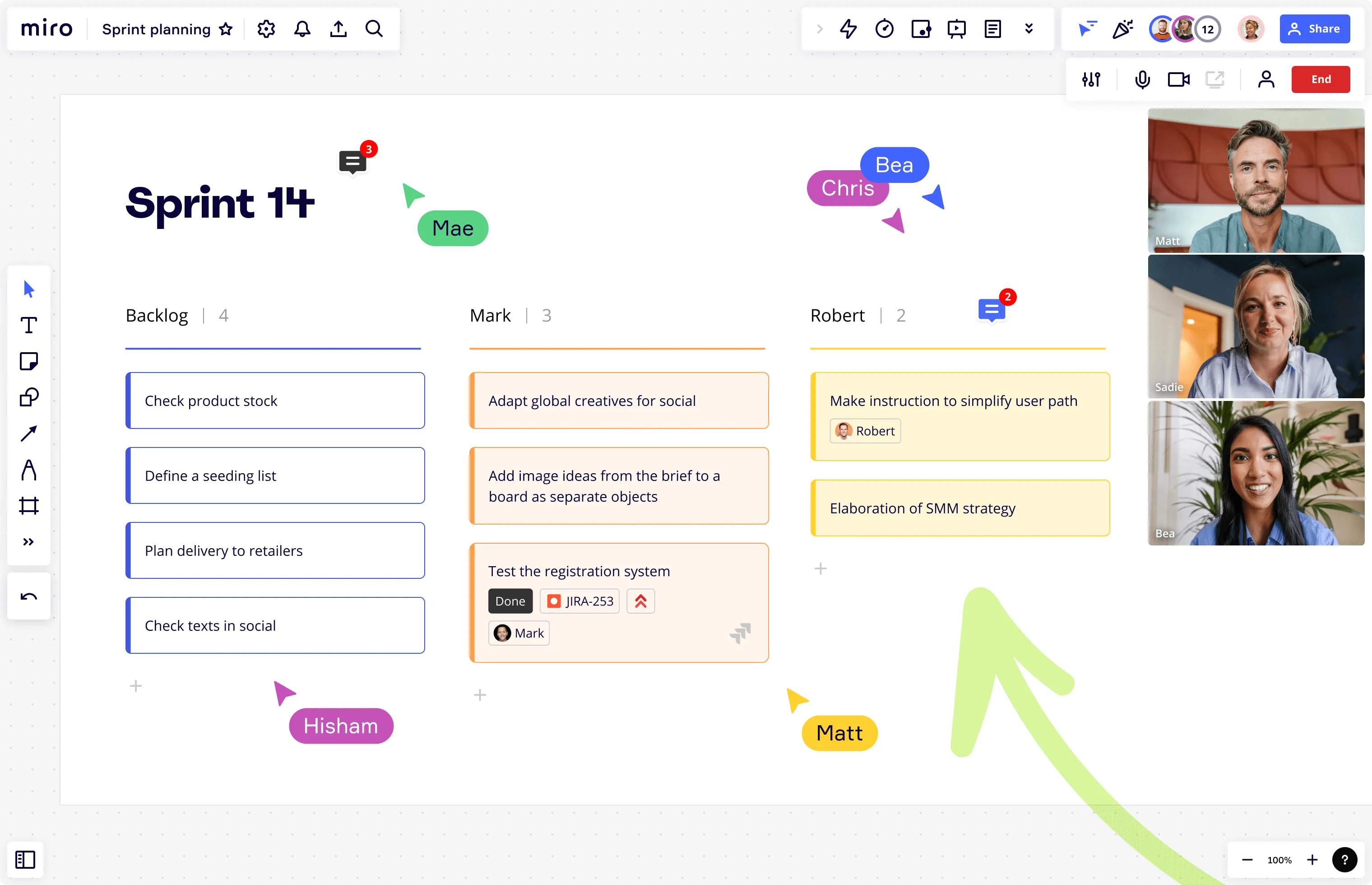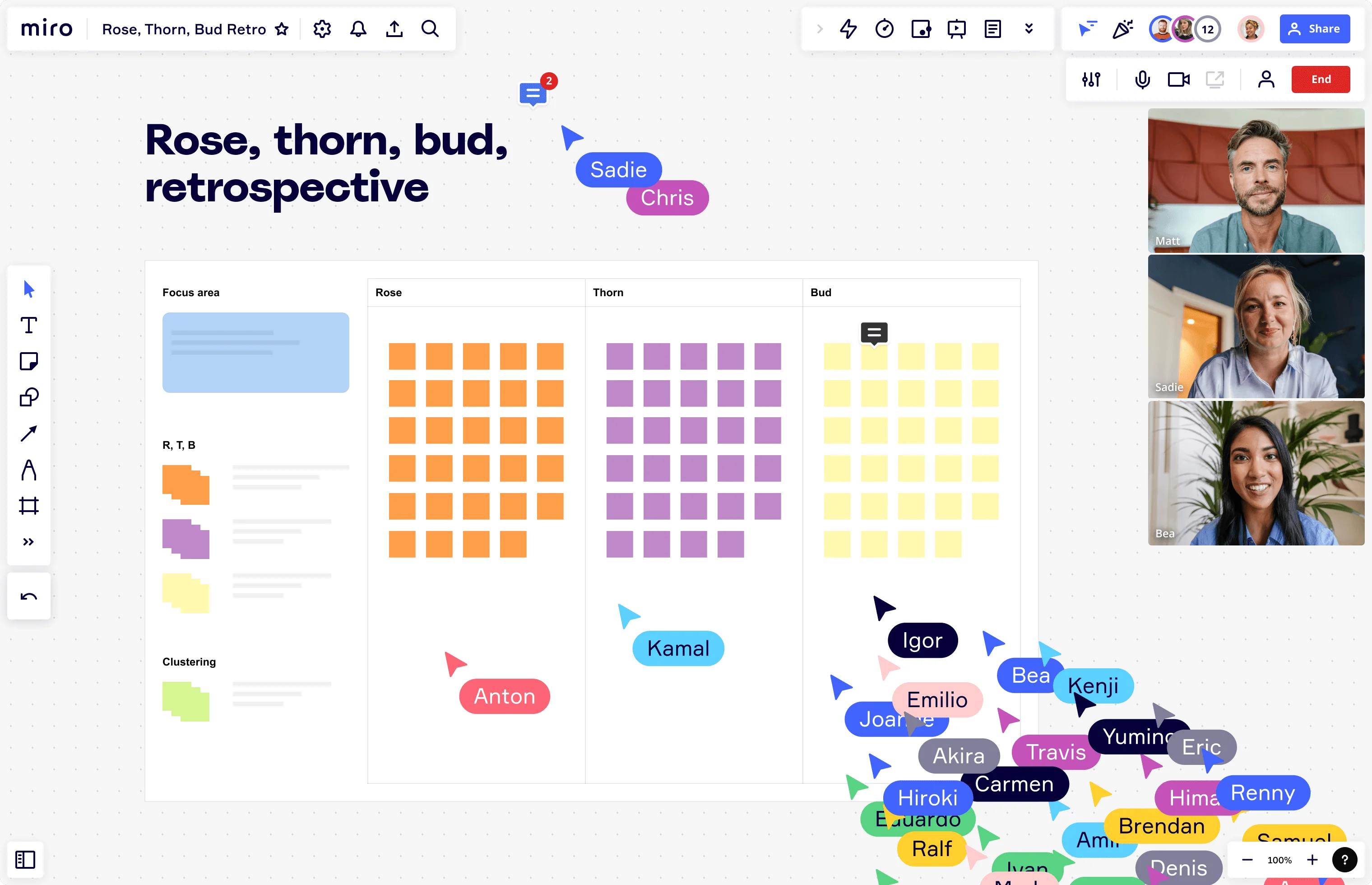
Sprint planning and review

How to hold sprint planning & review meetings
Agile management approaches help companies nurture innovation, enhance quality, and speed up the release-to-market in today's dynamic business landscape. Today, many organizations use Agile tools to manage software development and other non-IT projects. The Scrum framework is an essential part of Agile methodology. Scrum centers on the sprint — a short period when teams complete predefined tasks. Each sprint begins with a sprint planning meeting and ends when teams share and admire their finished work during a sprint review. But planning and wrapping a sprint is not always easy. In this article, we explore some tips to help Agile coaches, Scrum Masters, and their teams to optimize sprint planning and review sessions. We also examine how distributed and remote teams can visualize their collaborative efforts.
What is the Scrum framework?
Scrum is a framework within the Agile methodology to help collaborative teams solve complex problems. Scrum uses iteration in sprints to turn small tasks into valuable and useful deliverables, called increments. To create products or services that customers value, Scrum teams seek and incorporate feedback from the customer as they work through each sprint, and not just as quality control at the project end.
What are Scrum values?
At the heart of Scrum are its core values, which guide the behavior and mindset of everyone involved in the project. These values are:
Team commitment and focus
Scrum team members are committed to achieving their goals and delivering high-quality results. This means they prioritize their work and are accountable for their actions. It's hard to do good work when you're overworked and your attention is scattered across multiple projects with too many high-priority tasks, so Scrum teams work together to eliminate obstacles and deliver value to their stakeholders.
Transparency
Scrum team members are open and transparent in their communication and decision-making. They value feedback and are willing to admit when they need help or when they make mistakes. They also give visibility to their work by using charts and boards to help others see the tasks of each team member and how work is progressing.
Openness to change
Scrum team members are not afraid to take risks, speak up when necessary, and make difficult decisions. They value feedback and are willing to admit when they need help or when they make mistakes. High value is placed on customer input, and teams are encouraged to pivot if market and customer changes require adjustments.
Respect for fellow team members
Scrum team members treat each other with respect, empathy, and kindness. They recognize that everyone brings unique skills and perspectives to the project, and they value diversity and inclusivity. Agile and Scrum emphasize self-organized and self-directed teams. Scrum leaders and product owners support teams to achieve their best and guide them to align with goals rather than imposing command-and-control leadership.

How does Scrum work?
A Scrum team uses a product backlog, a prioritized list of work items, and pulls these items up through the backlog when the team believes the item can be completed. The team iterates on these work items, through received comments from the customer and other stakeholders, and includes those ideas in the work items until they are completed at the end of the sprint. The finished product or result is called an increment. The increment, product backlog, and the sprint backlog form the Scrum artifacts, the documents and activities that track the progress of a sprint.
Who is part of a Scrum team?
Scrum teams include the product owner, Scrum master or team leader, and any developers, designers, testers, or business analysts needed to complete the project or deliverable.
What is a sprint?
Work under Scrum revolves around the sprint, a period usually lasting two to four weeks. A sprint usually includes five meetings, called "events" in Scrum:
Backlog refinement
Sprint planning
Daily scrum meetings
Sprint review
Sprint retrospective
Sprints are a core part of the Scrum framework and provide a regular cadence for the team to deliver value to their stakeholders. During a sprint, the Scrum team works together to achieve the sprint goal, which is a short statement that describes what the team aims to accomplish during the sprint.
What is a sprint planning event?
A sprint planning event helps the team decide what work they will perform during the sprint, also called the sprint goal. In planning, the team chooses items from the product backlog, the detailed list of features and tasks required to complete the product or project goal, and adds them to their sprint backlog. The team then looks for dependencies between work items. Work for each item is estimated and later adjusted, if necessary. Finally, the team learns from the product owner (or further defines) the acceptance criteria for deliverables, or how the team knows when they have finished their work.
What happens in sprint planning?
In sprint planning, the whole team gathers to prioritize and plan work for a sprint. The purpose of sprint planning is to define what the team will deliver during the upcoming sprint and how they will accomplish it. The product or initiative owner works with the team to define the sprint goals. The team then decides what they will do in the sprint and how they will complete the work. It’s a type of pre-game meeting.
Who attends the sprint planning meeting and how long should it run?
A sprint planning session includes the product owner, the Scrum leader, the development team, and anyone considered part of the Scrum team. Sprint planning events can be as short as a half hour to one hour but at most eight hours. As a guide, budget two hours for planning every week in the sprint.
Tips for better sprint planning
Making an Agile transformation takes time and intention. Here are some tips for a productive sprint planning meeting:
Use a shared board
Have a dedicated work area where the team can collaborate. Teams need a space where they can easily talk, help each other, and think out loud. The team area is also the space for a dedicated Agile board, with items organized on sticky notes or tracked on a Kanban board.
Come prepared
Are you the product owner? Before the planning meeting, be prepared to import Jira issues and retrospective ideas into your Agile board. Start with a well-groomed or refined backlog. Don't waste time distracting people with completed items.
Set clear goals
Present the sprint goal during the planning meeting, so everyone starts their work during the sprint oriented in the same direction. Introducing a goal halfway through the sprint is too late.
Agree as a team
For new teams, create a team working agreement. Use a template like this team agreement template to devise and communicate agreed-upon goals.
Define the end state
Set a clear definition of "done" to help people know what they're working towards in the sprint and the level of quality desired. Clear definitions reduce misunderstandings and eliminate excuses.
Clarify acceptance criteria
Ensure that all backlog items have clear acceptance criteria. People need to know what quality level to work towards and when to consider their work finished.
Foster a shared Agile culture
New teams need training in Agile principles and practices to ensure everyone is working with the same Agile values. Be sure to get everyone on the team up to speed so they understand the goals the team is working toward.
Keep meetings short
Make sure meetings stay on track and keep discussions focused on the main topic. People will enjoy attending productive meetings that don’t detain them too long from their work.
Break the ice
While meetings should be concise and on topic, icebreaker games can be incorporated so new team members can get to know one another, and existing teams can reconnect and build fellowship.
Limit technical debt
Technical debt, old code, patch jobs, and improvised practices may impede progress on new items.
What is a sprint review?
A sprint review happens at the end of a Sprint. During the review, the product owner presents and assesses whether teams met the sprint goal. The product owner ensures that each user story or deliverable meets the predefined criteria. Team members and outside stakeholders attend and may have comments and questions about the sprint results. A sprint review also allows teams to socialize and celebrate their success.
What happens in a sprint review?
A sprint review demonstrates and assesses the team's work during the previous sprint. The product owner compares features and work items to acceptance criteria to determine if work is complete and to see whether the product or deliverable is shippable as it is. Stakeholders provide feedback on the product. Teams may adjust the product backlog according to the results of the review. The team also uses the review meeting to celebrate their accomplishments during the sprint and allows space for team bonding.
Who attends a sprint review and how long should it last?
The entire Scrum team and invited stakeholders should attend the review meeting, preferably synchronously, whether in person or as a hybrid meeting. Generally, a review meeting should last at most 4 hours. A good guide is to plan one hour of review for every week in the sprint.
What's the difference between a sprint review and a sprint retrospective?
A sprint review meeting precedes the sprint retrospective. Though similar in nature, they have different goals. A review is meant to demonstrate and celebrate the results of a sprint's worth of work. It includes the team and other stakeholders. During the review meeting, the product or initiative owner determines if the team met the sprint goal and if the output meets acceptance criteria. A sprint retrospective, on the other hand, focuses on the effectiveness and efficiency of the team during the sprint. It considers processes and what worked and what could be done differently. A retrospective allows the team to plan for process improvements and build on (and continue) successful practices. Miro's sprint retrospective template provides a useful framework to workshop this with your team.

Tips for a better sprint review
Holding a review at the end of a sprint gives team members space to reflect and celebrate their work. Here are some tips for running successful and engaging sprint review meetings:
Make it a shared experience
Meet with the entire team, even if part of the team works remotely. Making it a collaborative meeting ensures team members are engaged and heard throughout the entire sprint.
Hold a separate retro
While they are both a time for reflection, a retrospective meeting focuses on how the team worked together, including internal processes and workflows. Sprint reviews are all about the product — what was shipped and how does it meet customer needs.
Record your achievements
Make short demonstration videos and board recordings so people in different time zones can share in the success. Team members will also be able to come back later to revisit and find inspiration for future work.
Stay on time
Time box your sprint review meeting. It’s possible to have too much of a good thing. Just as you limit your planning meetings, stick to an agenda for the sprint review, and don't let the meeting run on and on.
Focus on the user story
Demonstrate only items that fulfill user story requirements and criteria. When you devote time to work items that fall short of the criteria, you waste everybody's time.
Celebrate as a team
Use the review as a celebration of the team. A well-run sprint review builds morale and fuels continued collaborative effort and innovation.
Optimize and streamline your sprint execution with a customizable sprint planning template from Miro's template library.